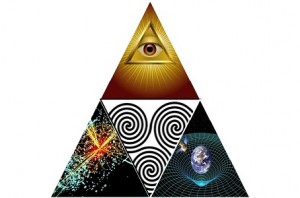Purpose
Human civilization is dotted by a common theme indicating that all things are connected. As one thinks about what we have in common with all that lives, our commonalities become far greater than our differences. In our modern society, we have divorced art, science, mathematics and philosophy from religion. These areas of study are kept separate. But as our understanding expands, gaps between these pillars of knowledge can be bridged. The resulting integration of ideas adds depth to our comprehension. The purpose of this theorem is to serve as a possible bridge. The resulting synergy in our understanding translates into greater respect for all things that share in our existence.
The purpose of this theorem is not an end in itself. It is simply another perspective of the universe around us and an effort to understand our rôle in it. I have faults. I am imperfect. However, Our Creator is perfect. It is unlikely that I have captured a complete and accurate picture of The Most High. All readers are encouraged to find fault and even disprove this second theorem that the existence of a Supreme Being is likely.
Hypothesis
The foundation of the first theorem is rooted in logic and philosophy. Science is then overlaid on this philosophical foundation. The first theorem takes an inductive approach to scientifically prove a theorem that a Divine Being exists. If God truly does exist, one should be able take a deductive approach within the confines of our known science to fortify the hypothesis that our Creator does exist. Allegorically, the first theorem used a spyglass to peer into the heavens. The second theorem attempts to use these allegorical principles of optics to convert the spyglass into a microscope. In so doing, each theorem should not only be congruent but Theorem Two should be an affirmation of Theorem One.
The following Proofs build on basic science to better understand our existence in a larger context.
Proof A
Matter ≈1 (some very large, finite unit of measure, Macronamus)
Energy ≈ 1 (some very large, finite unit of measure, Macronamus)
Matter ≈ Energy (aka The Laws of Conservation)
Proof B
Time ≈ ∞ (time is limitless, possibly a mobius strip)
Space ≈ ∞ (space is limitless, possibly a mobius strip)
Time ≈ Space (aka the Space – Time continuum)
Proof C
Matter & Energy cannot exist without Time & Space
Time & Space can exist in the absence of Matter & Energy
Therefore, Time & Space > Matter & Energy (a subset of ∞)
Proof D
Time & Space must exist before Matter & Energy
Matter & Energy must be created in Time & Space
The Creator can exist beyond Matter and Energy
Proof E
A Life Spark (aka Spirit or Soul) exists
A Life Spark does not obey the laws of Matter & Energy
Therefore a Life Spark exists in Time & Space but outside Matter & Energy
Proof F
A Life Spark exists in Time & Space but outside Matter & Energy
The Creator exists in Time & Space
A Life Spark is a shared existence with the Creator

A treatise has been written to explain the logic behind this theorem. If you have an Adobe reader, you can download a free copy of this article. This document can be found in the TREATISE 2 section.

